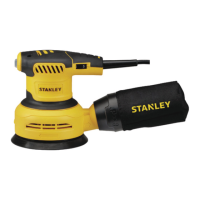ENGLISH
6
Description (Fig. A)
WARNING: Never modify the power tool or any
part of it. Damage or personal injury could result.
1. On/off switch
2. Electric speed control dial
3. Dust bag
4. Dust bag collar
5. Dust extraction outlet
6. Sanding pad
7. Sanding paper
ELECTRICAL SAFETY
Only one voltage is applicable to this tool. Be sure to check
that the power supply corresponds to the voltage on the
rating plate.
Your Stanley tool is equipped with double
insulation, hence, it does not require to be
earthed
When the power cord is damaged, have it sent to a
STANLEY service center for replacement to specially
prepared cables.
USING AN EXTENSION CABLE
If an extension cable is required, use an approved 3–core
extension cable suitable for the power input of this tool
(see Technical Data).The minimum conductor size is 1.5
mm
2
; the maximum length is 30 m.
When using a cable reel, always unwind the cable
completely.
ASSEMBLY AND ADJUSTMENT
WARNING: To reduce the risk of serious
personal injury, turn tool off and disconnect tool
from power source before making any
adjustments or removing/installing attachments or
accessories. Before reconnecting the tool, depress and
release the trigger switch to ensure that the tool is off. An
accidental start-up can cause injury.
Fitting sanding paper (Figure. B)
Warning! Never use the tool without a sanding
paper or accessory in place.
The tool uses 125 mm (5”) hook and loop sanding
paper with an 8 hole dust extraction pattern.
1. Place the tool on a table, sanding pad (6) up.
2. Place the sanding paper (7) directly on top of the
sanding pad.
3. Hold the sanding pad with one hand and align the dust
extraction holes.
4. Press the sanding paper firmly onto the sanding pad.
Setting the Electronic Speed Control Dial (Fig.
A)
The speed is infinitely variable from 0–13,000 min
-1
using
the electronic speed control dial (2).
Turn the electronic speed control dial to the required level.
The correct setting, however, is a matter of experience.
Generally, harder materials require a higher setting.
Dust Extraction (Fig. C)
WARNING: Since woodworking with a sander
produces dust, always install a dust bag
designed in compliance with the applicable
directives regarding dust emission.
WARNING: Do not use a dust bag or vacuum
extractor without proper spark protection when
sanding metal.
Your sander has a dust extraction methods: a
built-in outlet (5) which allows either the supplied
dust bag (3) or a shop vacuum system to be connected.
TO ATTACH THE DUST BAG
1. While holding the sander, fit the dust bag collar(4) to the
outlet (5) as shown in Figure C.
2. Turn the collar (4) anticlockwise to lock the dust bag
(3) in place.
TO EMPTY THE DUST BAG
NOTE: Be sure to wear approved eye protection and
approved dust mask when performing this procedure.
For efficient dust extraction, empty the dust collector
when it is about one third full.
1. While holding the sander, turn the collar (4) clockwise to
unlock the dust bag (3).
2. Remove dust bag from the sander and gently shake or
tap the dust bag to empty.
3. Reattach the dust bag back onto the outlet and lock into
place by turning the dust bag collar clockwise.
USE
WARNING:Let the tool work at its own pace. Do
not overload.
WARNING: Always observe the safety
instructions and applicable regulations.
WARNING: To reduce the risk of serious
personal injury, turn tool off and disconnect tool
from power source before making any
adjustments or removing/installing attachments
or accessories.
WARNING:
♦ Make sure all materials to be sanded are well
secured.
♦ Apply only a gentle pressure to the workpiece.
Excessive pressure does not improve the sanding
effect, but only results in an increased load on the
machine and causes the abrasive to tear.
Avoid overloading.

